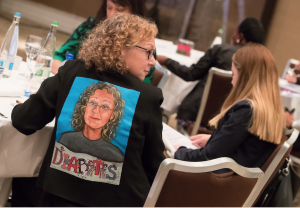How to Make the Diagnosis of Type 2 Diabetes Less Difficult – Scott’s Diabetes

[00:00:00] Scott K. Johnson: Welcome to BDI Briefs. This is another exciting installment where we take a brief look at important issues about the emotional side of living with diabetes and working in diabetes. Thanks for joining us today. I’m here with Dr. Bill Polonsky. President of the Behavioral Diabetes Institute and Dr. Susan Guzman, Director of Clinical Education at the Behavioral Diabetes Institute. Both are world-renowned diabetes psychologists and two of my favorite people to talk with.
My name is Scott Johnson. I have lived with diabetes for over 40 years and have been active in the diabetes social media space and industry for a long time.
And with introductions out of the way, Bill, what are we talking about today?
[00:00:53] Dr. Bill Polonsky: Thanks, Scott. I want to bring up a subject that really doesn’t get enough attention. And this has to do with what happens to people with type 2 diabetes when they’re first diagnosed. The day they first discover that they have type 2 diabetes. And often not appreciated is What a very difficult moment this is for folks. There’s often a very strong emotional response and often a very strong negative emotional response. People feel frightened about what this means for my future, about how other people are going to see me. Worries about, just the disappointment and the discouragement that I thought I was doing everything as well as I could, and how could this be? This sense of mortality, is my life going to be shortened? So many strong emotional responses that, if not really ever addressed, really can lead to people not really effectively engaging with their diabetes.
So it can lead to people saying, I’m not going to think about it. And can lead to really bad outcomes over the course of time.
So, as healthcare professionals, we know we have this special moment when we are sitting with someone who’s first learning they have type 2 diabetes. How we talk about that with people can have an enormous impact.
And the reason we’re talking about it today is, as we’ve been going through the recent literature, a series of recent articles really struck me.
Small, Qualitative studies that come from our colleagues. I’m going to tell you the name of the first author here. I’m terrified I’m going to mispronounce it, but I think it’s pronounced Boakye; it’s spelled B O A K Y E. So she and her colleagues have really put forward about these three wonderful articles that have been published over the past few years that really have highlighted, first of all, how very common these really profound and worrisome negative emotional responses to the diagnosis of type 2 diabetes can be (https://pubmed.ncbi.nlm.nih.gov/36714250/).
And also, the importance of them also mentioning how rarely these feelings are ever addressed, ever brought up, ever asked about with their health care providers, and how common it is for people not just to be frightened and worried about the future but feel abandoned with their type 2 diabetes, like not really quite sure what they need to do next, and feeling like there’s anyone really on their side that’s really supporting them.
And she’s also, she and her colleagues have highlighted in these articles what patients want and what they need, how they want to be asked about some of their feelings about learning they have diabetes; they have their questions answered and are offered better support. So, I highly recommend you check out some of these articles. They’re in Clinical Diabetes and Diabetes Spectrum, just published over the past couple of years.
The bottom line is that what these articles have told us brings up something that we’ve actually known for many years: there’s this enormous problem, and we can do better. What should we do, and how do we go about that? Now, I’m proud to say we have looked at this over the years by my colleagues and myself over the past few decades.
In fact, way, way long ago, way back in 2017, we actually published the first of a series of articles where we had surveyed more than 3, 500 people around the world. It was from 26 countries. And we asked them, these were all people with type 2 diabetes, about what happened to them when they were diagnosed, both good and bad, and specifically, we wanted to know what happened to them in their interactions with their health care provider.
And one of the things we focused on is what happened at those moments that was really good for you. That helped you to feel okay about living with type 2 diabetes over the course of the next few years and actually taking on the tasks of type 2 and feeling okay about it and being able to succeed.
In our studies, these two elements really stood out. And when I tell you, you’re going to go, of course, but it’s hard to put into practice often.
One is the degree to which healthcare providers managed to put forward messages to these newly diagnosed patients that were encouraging.
To let people know that this is not a death sentence that you have type 2. Odds are pretty good here in the 21st century. Odds are good you can live a long and healthy life with diabetes with good care and effort. And providing the sense of encouragement about what type 2 means and how you can do. But also doing it, and this is the second point, in a collaborative fashion.
So not just telling people this, but having a conversation. Asking people what their concerns are. Asking them what their questions are. Making sure that people knew that, as best as possible, a person and their health care team are going to do this together. We’re going to meet again soon. We’re going to see where we go next.
We’re going to try to put together a plan that’s doable for you. And those two elements, as it turns out, made an enormous impact on helping people to be successful over time. Now, in these recent articles from Boakye and colleagues–and again, just in case any of her, she, or her colleagues who are listening now, I apologize if I’m saying your name wrong–they’ve really done a nice job in one of the last articles about putting forward these key themes about what we as healthcare providers need to do with our patients. It’s from their 2022 article in their first figure. And this really seems to follow nicely from our own paper. And it’s about the importance of doing this, not just to tell people this, but as a conversation.
So I want to, take a moment and talk about what they’ve put forward in this lovely figure. And I can’t do it as well as my colleague, Dr. Guzman. So Susan, please take us through a little bit of what’s on this table.








